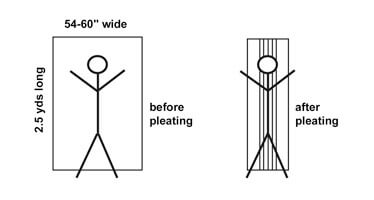Cheater Pleat Your Earasaid
This is an Add On item that is a nice and convenience option. Your earasaid will still look like you pleated it yourself, but you can take it off and put it back on any time you want to without redoing your pleats. We'll pleat the earasaid for you and stitch a waistband inside to hold it all together. (A belt will still be necessary to hold your earasaid on.)
First decide how you will be wearing your earasaid:
Method #1: The earasaid will be worn from knee to mid-calf length (maximum of about 27" long). You should be able to bring fabric over one shoulder or both, and brooch it in front. You should have plenty of pleats, and enough fabric meet in the front, or overlap a bit if you want it to. A 2.5 yard earasaid will fit up to about a 34 inch waist, a 3 yard earasaid will fit up to about a 40 inch waist, and a 4 yard earasaid will fit 40+ inch waist sizes.
[caption id="attachment_451915" align="alignnone" width="374"] Earasaid Pleating Method 1[/caption]
Earasaid Pleating Method 1[/caption]
Method #2: The earasaid will be worn floor length. You should be able to bring fabric up over your head if you want to, and brooch it like a hooded cloak. Worn this way you'll be limited by the width of the fabric. You can make your earasaid fit almost any waist size, but you'll have only a few pleats, and just enough fabric meet in the front (maybe). This method works best with a 2.5 yd earasaid. You can make it work a 3 or (maybe) 4 yard earasaid, but you end up with too much fabric to deal with above your head and shoulders.
[caption id="attachment_451917" align="alignnone" width="374"] Earasaid Pleating Method 2[/caption]
Earasaid Pleating Method 2[/caption]
Next decide on your options:
Split Front — The most common option. Allows your underdress to show more under your earasaid. In general we'll try to pleat your earasaid so the aprons almost meet, with maybe a 1 or 2 inch gap. If the earasaid you have chosen is smallish for your waist size, we may leave up to 6 or 8 inches open in the front.
Overlapping Aprons — Makes your earasaid look more like a greatkilt. The aprons will not overlap as much as a kilt does, because they're intended to split open at the bottom, revealing the underdress. Usually this option means sacrificing a couple of pleats.
Pleat to Sett — The most common option. Each pleat is positioned so that the pattern (sett) appears to continue through the pleated portion of the earasaid.
Pleat to Stripe — We choose a prominent stripe in the pattern and center the stripe down the middle of each pleat. For kilts, this is a traditional military style. For an earasaid, it is a personal style preference, and can look very nice. Some tartans just don't look good pleated to stripe however. If you choose this option we will let you know if it can't (or shouldn't) be done.
Box Pleats — Another traditional military style. Every other pleat is reversed. This creates pleats twice as wide (3-4 inches wide depending on the sett width of the tartan you choose) with tartan folded under both edges of the pleat. Box pleating uses less tartan, so you can get by with a 2.5 or 3 yard earasaid for any waist size.
Do Not Iron — Will give the appearance that you just pleated it yourself.
Lightly Iron — Will help shape the pleats but still look rustic.
Crisply Iron — Will defined the pleats and give them a more formal look.
How To Measure:
Waist: Measure your waist size where you will be belting on your earasaid.
Length: Measure the length starting from your waist where you will wear your belt. If you plan to wear a 2.5 yd earasaid the long way (method #2), you can choose any length up to floor length. Otherwise, maximum length is about 27 inches. Have someone help you measure. If you bend even a little while trying to do it yourself, the measurement will change.
